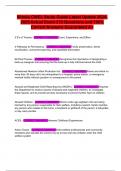Illinois CWEL Study Guide Latest Update 2024-
2025 Actual Exam 270 Questions and 100%
Correct Answers Guaranteed A+
3 E's of Trauma - CORRECT ANSWER: Event, Experience, and Effect
4 Pathways to Permanency - CORRECT ANSWER: Family preservation, family
reunification, concurrent planning, and expedited termination
60-Plus Process - CORRECT ANSWER: Recognizes the importance of designating a
back-up caregiver and ensuring that the back-up is fully informed about the child
Abandoned Newborn Infant Protection Act - CORRECT ANSWER: Allows and infant no
more than 30 days old to be relinquished to a hospital, police station, or emergency
medical facility without question or consequence to the parent
Abused and Neglected Child Reporting Act (ANCRA) - CORRECT ANSWER: Requires
the Department to receive reports of abused and neglected children, to investigate
these reports, and to provide services necessary to prevent further harm to children
Abused Children - CORRECT ANSWER: Minors under age eighteen who are being
harmed by any person responsible for their welfare, including a parent, family member,
any person who resides in the home, a boyfriend or girlfriend of the parent, a babysitter,
or day care provider
ACES - CORRECT ANSWER: Adverse Childhood Experiences
Action Teams - CORRECT ANSWER: Child welfare professionals and community
members who educate the community as to how and why children enter the child
welfare system
,Adjudicatory Hearings - CORRECT ANSWER: Hearings wherein the judge decides if
the evidence presented shows that the child was abused, neglected, or is dependent.
Administrative Case Review (ACR) - CORRECT ANSWER: Assists workers,
supervisors, and families in recognzing practical case objectives, reviewing
implementation of service plans, documenting family progress, and planning
permanency for children
Administrative Case Review (ACR) - CORRECT ANSWER: Required for placement
cases every six months by DCFS policy. Discusses whether there has been progress
toward achieving the outcomes defined in the prior service plan, whether there are
barriers that have prevented the achievement of the outcomes and how those barriers
can be reduced, whether the services are appropriate, whether the permanency goal
has been achieved, what objectives should be established for the next six months, and
what alternative plans should be considered if the family has not complied with the
service plan
Adoption Act - CORRECT ANSWER: Specifies the grounds for parental unfitness and
procedures governing adoption of children
Adoption and Safe Families Act (ASFA) - CORRECT ANSWER: A federal statute that
requires states to take specific placement action on behalf of children in foster care,
such as terminating parental rights in order to facilitate adoption after a designated
period of time trying to reunite the child with its biological parents.
Adoption Caseworker - CORRECT ANSWER: Assist children in becoming a legal
member of an adoptive family when efforts to unite children with their parents are not
successful
Adoption Hearing - CORRECT ANSWER: The Court grants legal custody of the minor
child to his/her adoptive parents
Adult Guardianship - CORRECT ANSWER: Transitions youth age 17 1/2 and older with
developmental disabilities to DHS funded adult living arrangements
,Aristotle P V. McDonald - CORRECT ANSWER: Requires DCFS to make a diligent
search to locate joint placement for siblings, as well as place siblings together, unless
there are certain exceptions
Assumptions - CORRECT ANSWER: Ideas, beliefs, predictions, suspicions, and
inferences about various aspects of life, e.g. experience, people, religion, politics,
justice, etc.
Attachment - CORRECT ANSWER: Occurs as a result of children expressing their
needs and mothers or primary caregivers satisfying the children's needs each time they
are expressed
Attachment Disorder - CORRECT ANSWER: Occurs when children's normal processes
of attachment have been disrupted. Children may become severely withdrawn and
depressed, or they may be very destructive and aggressive
Back-Up Planning - CORRECT ANSWER: The plan the caregiver (and extended family)
have developed for ongoing care for the child if the time comes when the older
caregiver can no longer care for the child
Bates V. McDonald - CORRECT ANSWER: Requires DCFS to provide weekly parent-
child visits for children in substitute care with a "return home" goal
Beliefs - CORRECT ANSWER: The convictions, expectations, faith, hopes, and
assurances people have about various aspects of life
BH V. McDonald - CORRECT ANSWER: Requires DCFS to protect children in custody
from foreseeable and preventable harm, provide minimally adequate health care
including mental health care, and provide minimally adequate training, education, and
services to enable children to secure their own safety
Bias - CORRECT ANSWER: Preconceived judgment or opinion; an adverse opinion or
learning formed without just grounds or before sufficient knowledge; an irrational
attitude of hostility directed against an individual, a group, etc.
, Bonding - CORRECT ANSWER: The initial tie that develops between newborn babies
and their mothers
Borderline Personality Disorder - CORRECT ANSWER: Characterized by impulsivity
and instability in mood, self-image, and personal relationships
Burgos V. Suter - CORRECT ANSWER: Requires DCFS to provide services in Spanish
for Spanish-speaking clients
Case Handoff - CORRECT ANSWER: The DCFS investigator gives the case
information to the placement worker and their supervisor
Case Law - CORRECT ANSWER: Based on court decisions and interpretations
Case Transfer Staffing - CORRECT ANSWER: The Child Protection Specialist
supervisor must hand off the case to the intact or placement supervisor and transition
the case with family members
Change Agents - CORRECT ANSWER: Begin intervention by establishing a relationship
with the family so that families may change their behavior and learn healthier patterns of
relating to each other and more appropriate discipline techniques
Child Abuse and Neglect Tracking System (CANTS) - CORRECT ANSWER: Prior
history of reports of abuse or neglect in Illinois
Child and Adolescent Needs and Strengths (CANS) - CORRECT ANSWER: A tool for
assessing risk that: gathers information about the child, assesses the need and level of
intervention needed for treatment, enables communication about needs and strengths
of clients, provides us with information needed to make trauma-informed decisions, and
provides us with the data needed to document the impact of our decisions




